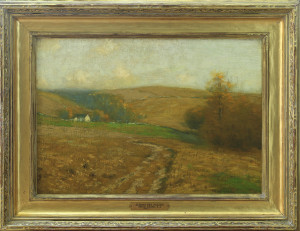
Bruce Crane
(1857-1937)
I became acquainted with Bruce Crane’s work at the very beginning of my father’s interest in attaining a few American paintings. On the advice of Ken Lux, he bought this small picture of the Statue of Liberty painted in an almost monochromatic palette and with an inscription to a friend. The second example is a classic Old Lyme landscape with a very personal story. Over many visits to the Salmagundi Club in the mid-1960s I became friends with an elderly member in his early seventies named Digby Chandler. We often talked about the other characters that were artist members and their stories. When I received my first overseas assignment to India in 1967, I celebrated that evening at the Salmagundi Club and met Digby at the bar. I told him excitedly of my departure, and he suddenly became quiet and distant, saying to me, “You know, Tom, I won’t be here when you return.” Rather embarrassed, I grasped the significance of my departure and I assured him that this was not the case. Digby went on saying that his kids had no interest in his paintings and asked whether I’d ever seen his own collection of paintings accumulated over decades. As I studied the large numbers of paintings hanging on his apartment walls, Digby Chandler posed a challenging proposition, telling me that if I liked any of his treasured works, I could have them for whatever he paid for them, often many years earlier. At that specific moment I had a “collector’s epiphany;” I realized I had virtually no background or knowledge about the earlier American artists. I had spent my brief year or so of interest in art focused on living artists. Therefore, I had no way of judging whether these works were significant examples by important artists or the imaginings and fantasies of an elderly gentleman. I said to myself, “You’re either a poser or a dilettante, or you’re going to take your growing love of art seriously….” And I selected about four pieces and basically emptied my meager bank account before departing for India. The Bruce Crane snow piece, entitled The Country in November, was the most significant example I purchased and clearly the one that has lasted most fondly in my collection. I also vowed I would not find myself again so lacking in knowledge and ill-prepared to take advantage of future opportunities. From that moment forward I began my life study of American art, or at least the periods, styles and artists that appealed to me. And Digby Chandler was right; I never did see him again, but I do owe him a great deal. More than thirty years elapsed before I acquired a third example by Crane. I had long coveted a rare, early example that uses the device of winter, grey overcast sky with a band of late-day yellow light stretching across the horizon… and finally located a masterful example in 2006. If I was fortunate to obtain the first two Cranes at a good price, I paid the penalty on this one.